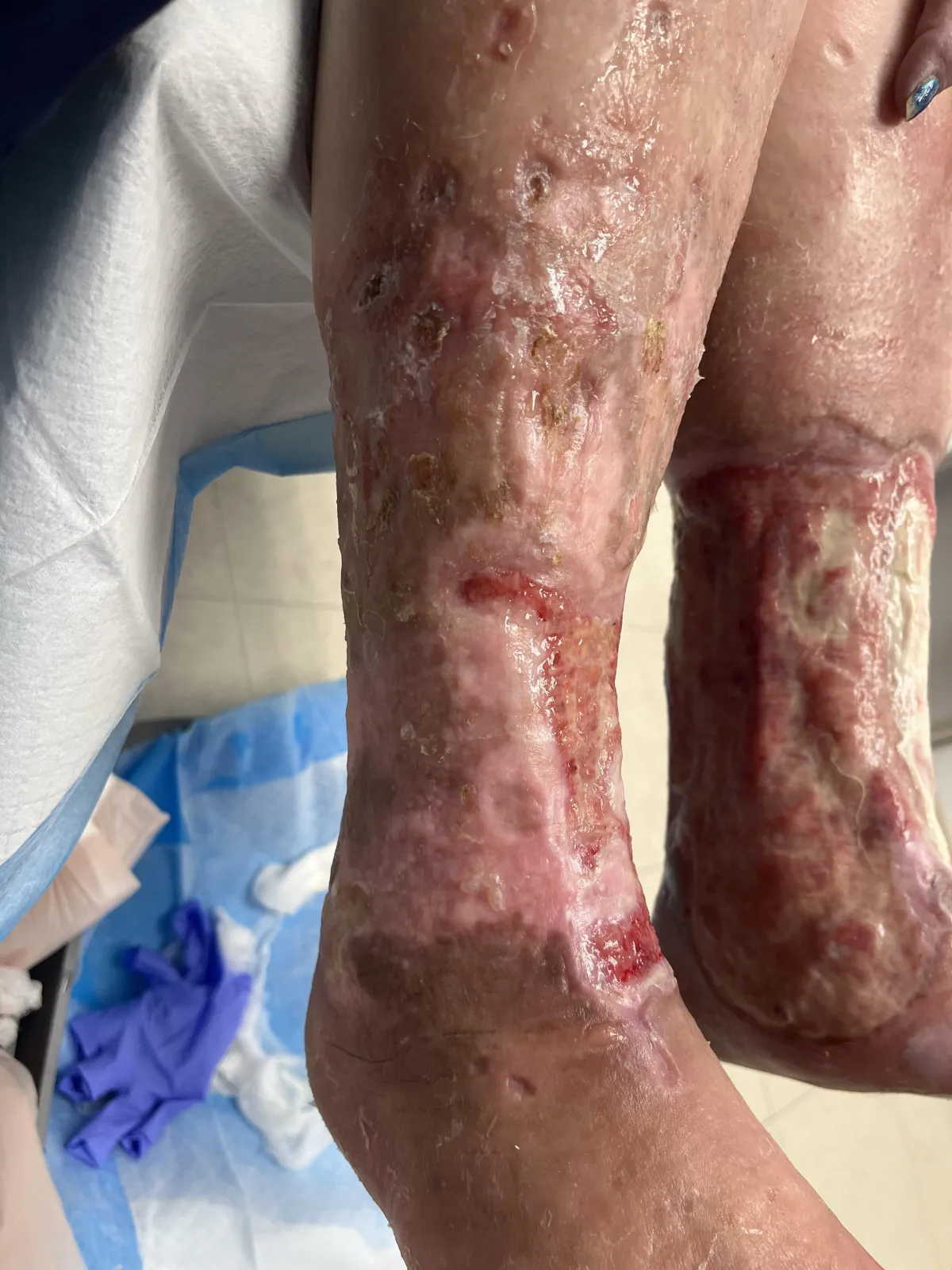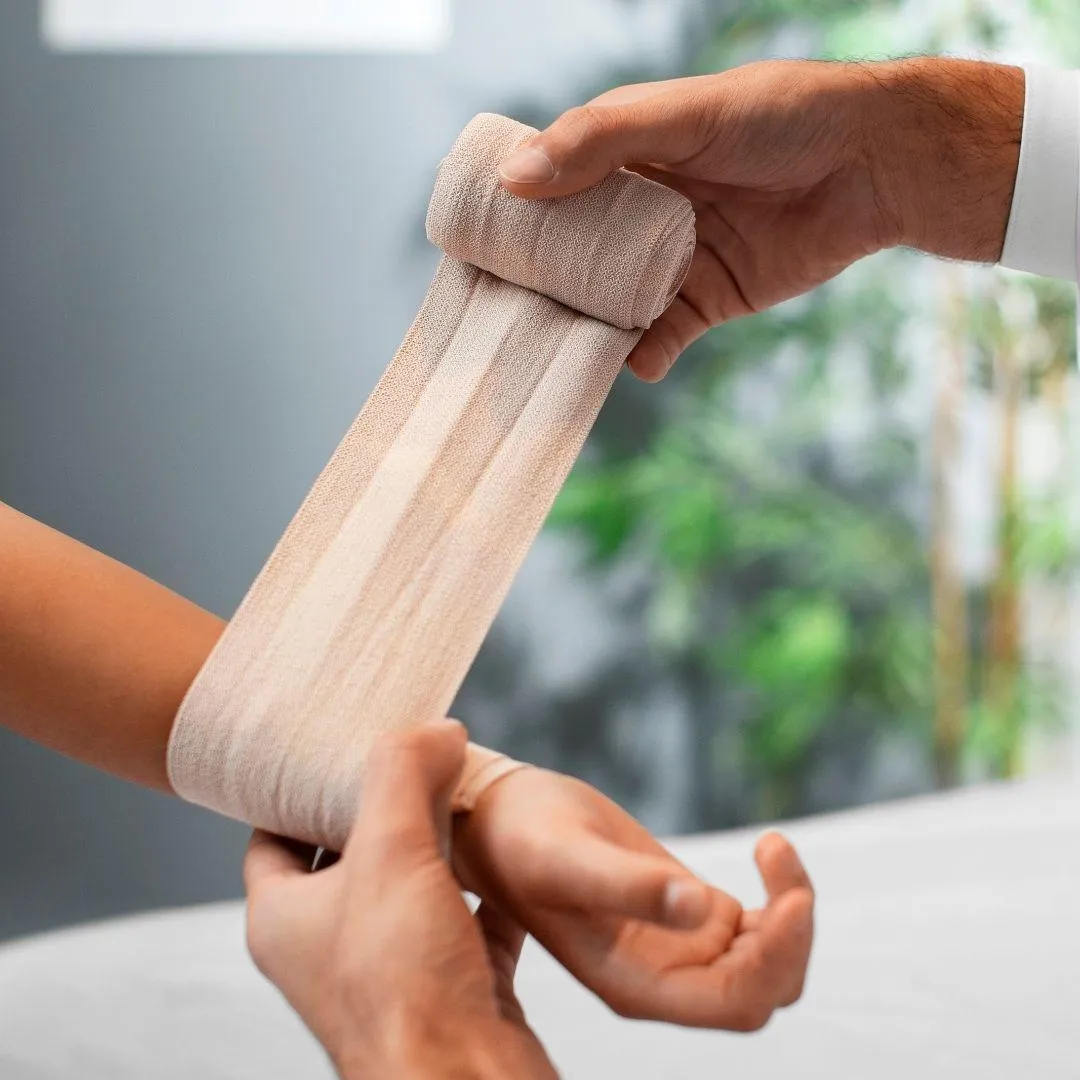Chronic Wounds: When Healing Stalls
Chronic wounds are wounds that don't heal in the expected timeframe, often taking weeks or even months. Unlike acute wounds that follow a predictable healing process, chronic wounds get stuck due to various underlying factors.
Find Wound Care Near You
If you or a loved one is struggling with a wound that won’t heal, a Royal Wound Care Wound Care Center can help. Since there is no need for a referral, your treatment is only a click and call away.
Common Causes:
Vascular Disease: Poor blood circulation can deprive tissues of oxygen and nutrients.
Diabetes: High blood sugar can impair wound healing.
Pressure Injuries: Prolonged pressure on the skin, often in immobile patients.
Infection: Persistent infection can hinder the healing process.

If you have a wound that isn't healing, seek medical attention. Proper wound care and addressing the underlying cause are crucial for healing.

The Impact of Heart Health on Wound Healing
1 in 2 Americans suffer from a cardiovascular disease. Coronary artery disease, peripheral artery disease and other issues with the heart and vessels can cause blockages that obstruct the flow of blood.

Royal Wound Care At Home: A Nurse’s Step-by-Step Checklist
Royal Wound Care At Home: A Nurse’s Step-by-Step Checklist
There are many patients who have limited mobility, inaccessible transportation, and complex medical needs that make frequent office visits unrealistic. Therefore, providing at-home wound care is an essential part of bridging the gap between healing and comfort.
By bringing expert care directly into the home, nurses can offer the kind of personalized attention that promotes healing, prevents infections, and supports a faster recovery process. As a direct result, both patients and nurses can enjoy better outcomes and reduced hospital readmissions.
Today, we will share a comprehensive wound care at-home guide for nurses. We will discuss necessary tools and instruments, as well as a step-by-step guide to performing wound care at home. We will also explore why partnering with Royal Wound Care can help you gain access to a clinical ally.

Royal Wound Care At Home: A Nurse’s Step-by-Step Checklist
At Royal Wound Care, we don’t view patients as treatment plans—we view them as people. This is why we offer Mobile Wound Care, where our partnership enhances patient outcomes and supports healthcare providers.
Through evidence-based protocols, we ensure safe, effective, and compassionate care—right in the comfort of a patient’s home. Our goal is to support the body’s natural healing process while preventing complications. In light of this, today’s post will walk you through everything you need for proper at-home care. Let’s redefine the future of wound care together.
What Do You Need for Wound Care?
Proper preparation is critical for safe and effective wound healing. Here is a guide of essential tools and instruments every nurse should make sure they have on hand:
Proper Cleaning Agents
Proper cleaning agents for both patients and nurses are essential. And, remember, the nurse must first wash their hands with soap and water before applying any cleaning agents. After ensuring a sterile environment, they should immediately tend to the patient’s wound.
A nurse certified in at-home wound care should arrive with the necessary supplies, including sterile saline solution and antibacterial, fragrance-free soap. More severe wounds may require commercial wound cleansers, such as hypochlorous spray.
However, a nurse should avoid (and encourage patients to avoid) using harsh cleansers at all costs. Hydrogen peroxide and rubbing alcohol, for example, can kill fibroblasts, which are necessary for the healing process.
Related: Caring for Your Wound
Gloves and Face Masks
While nurses must wash their hands with soap and water, they must also ensure they have proper personal protective equipment (PPE). Disposable gloves and face masks protect both the nurse and the patient from the transfer of harmful bacteria.
Additionally, under OSHA, at-home health professionals are required to use PPE whenever they are exposed to hazards. Although this is case-by-case, employers must train professionals on when and how to implement these procedures.
Sterile Dressings and Bandages
When a patient requires expert care, their expectations exceed a simple Band-Aid and traditional tissue or paper towel. Nurses must come prepared with sterile dressings and bandages—especially for open wounds. Both tools are non-adhesive, ensuring patients won’t experience pain or further damage as they are changed.
Ultimately, dressings and bandages are essential for preventing infections, controlling potential contamination, and promoting faster healing. Additionally, by covering the wound with a sterile dressing, you can ensure a balanced, moist healing environment.
It’s important to note that nurses should avoid using wet-to-dry gauze, cotton balls, cotton wool, and adhesive tape. Each instrument contains small fibers that can stick to the wound, increasing both the risk of infection and additional pain.
Related: Avoiding Common Wound Care Mistakes: Expert Advice
Antibiotics and Petroleum Jelly
When necessary, nurses should carry both antibiotic ointment and petroleum jelly. However, whether or not they will use it largely depends on the type of the wound a patient has. Petroleum jelly is often used for non-infected wounds to keep the area moist and provide a protective barrier.
In comparison, antibiotic ointment is used for wounds that either pose a higher risk of infection or are already infected. Additionally, if a wound begins to show signs of infection, a nurse might choose to use ointment to reduce bacteria growth and promote faster healing.
Pain Relief
Depending on the patient and the wound severity, nurses are often permitted to administer pain-relieving medications. However, these treatments vary depending on factors such as patient history, wound location, healing progress, nutritional status, and overall health.
Medications most often used during at-home care are oral medicines, injections, IV therapy, topical treatments, or patches. In cases where a patient can take their medication independently, a nurse can help manage their schedule to ensure they don’t miss a dose or take the wrong amount.
Related: Nutrition and Wound Healing: Expert Strategies
Tweezers and Scissors
Though seemingly small, tweezers and scissors are important tools for at-home nurses. Medical scissors allow a nurse to customize dressings, remove old dressings, cut medical tape, or open sterile packages. Tweezers, on the other hand, can assist with dressing changes, hold sterile materials, and maintain cleanliness.
Also, tweezers can help nurses remove debris from wounds, such as splinters, glass shards, or insect parts (stingers or ticks). Although healthcare professionals will most likely be wearing gloves, tweezers also allow for precise, sterile manipulation without direct contact.
Medical Drapes
When a nurse is managing more complex wounds, they often carry medical drapes. This is an essential tool for reducing cross-contamination, controlling fluids, and maintaining a sterile environment.
More specifically, it’s not uncommon for a wound to bleed or release fluid during dressing changes. A medical drape prevents contamination to the surrounding area while reducing the possibility of bacteria entering the wound.

How to Do Wound Care At Home
Wash Your Hands
The first step for every at-home wound care treatment is simple: Wash your hands thoroughly with soap and water. Afterwards put on gloves and, if necessary, a proper PPE mask. This step is critical for removing any dirt, bacteria, and germs that may otherwise cause serious infections.
Think of it this way: a wound is an immediate entry point into the body. Any direct contact with it can introduce harmful pathogens. Although this may seem minor at first, small infections can quickly become life-threatening.
Stop Bleeding if Necessary
If necessary, apply gentle pressure with a clean cloth, and the wound should stop bleeding within a few minutes. If the wound is more severe, seek medical assistance and/or take the patient to the emergency room.
Clean the Wound
Before cleaning the wound, gather any necessary supplies. If you have to continuously move back and forth between stations, this can quickly cause cross-contamination and transfer harmful bacteria.
For most wounds, you can wash the area with saline solution and a mild soap or antiseptic. Afterward, gently pat the area dry using a fresh, sterile gauze pad. Make sure not to place the pad on the wound bed, so it doesn’t dry out too much.
Light pressure and gentle movement are crucial here. You do not want to rub, wipe, or scrub the area—this can damage the tissue, reopen the wound, or cause additional irritation.
Apply Ointment
Certain wounds require a thin layer of either antibacterial ointment or petroleum jelly to keep the area healthy and moist. This is an essential step for promoting a suitable healing environment. With gloves on, take a cotton-tipped applicator and gently dip it into a small amount of the ointment or jelly. Then gently apply a thin, light layer over the wound.
The right amount of moisture can help new skin migrate across the area more effectively. As a result, patients can experience better protection, reduced scarring, and less pain.
Redress the Wound
After applying ointment and/or petroleum jelly, cover the wound with a sterile dressing or a bandage. There are several reasons why proper dressing is so important in wound care. First, it protects the area from additional bacteria and pathogens, thereby reducing the risk of infection.
Second, research has long shown that a moist environment is critical for proper healing. If a wound dries out too much, it can increase the risk of infection and ultimately cause more pain. When a wound is properly covered, it maintains moisture balance and facilitates debridement.
Maintain a Healthy Healing Environment
As you continue to care for the wound, make sure to provide a consistent, healthy healing environment. This includes keeping the area moist, redressing the wound if necessary, and administering medication when it’s permitted.
Additionally, make sure you constantly monitor the wound for any signs of infection. Care doesn’t stop after the initial treatment—it involves regular check-ins to ensure everything is healing properly and remains complication-free.
Always Document Appropriately
Documentation is a critical but often overlooked aspect of wound care. As the nurse, make sure you always maintain a comprehensive record of both the patient’s condition and any care administered.
This should include the treatment plan, ongoing assessments, progress in healing, and continuous wound characteristics. Additionally, make sure the document includes patient history and lifestyle factors. Any information provided is important for communication with other professionals, ongoing care, reimbursement, and protection against legal claims.
At Home Wound Care Checklist

Providing thorough, attentive wound care at home ensures that patients heal safely, comfortably, and successfully.
Not all patients have access to wound care facilities, urgent cares, or hospitals. Because of this, at-home and mobile wound care are essential for helping patients safely and effectively heal. By learning the necessary tools and steps, at-home nurses can properly treat wounds of any kind.
If you’re looking for clinical care or expert advice, contact the experts at Royal Wound Care today. We offer in-clinic wound care and home health care to help patients through every step of their journey. For SNFs or independent nurses, visit our site to learn about the different education opportunities we offer.
WEST HILLS
7230 Medical Center Dr. Suite 100
West Hills, CA 91307
(818)–660–2977
BEVERLY HILLS
9735 Wilshare Blvd #210B
Beverly Hills, CA 90212
(818)–660–2977
If you are interested in making an appointment, please click here to find a Wound Care Center near you.
Request an Appointment at a Royal Wound Care Facility near you.
Royal Wound Care is the expert in wound healing. Our board-certified wound care specialists are ready to help you begin your healing journey. Click the button below to request an appointment at a Wound Care Center near you—no referral needed
© 2025 Royal Wound Care, LLC. All rights reserved.
site by Growth Partners Marketing

